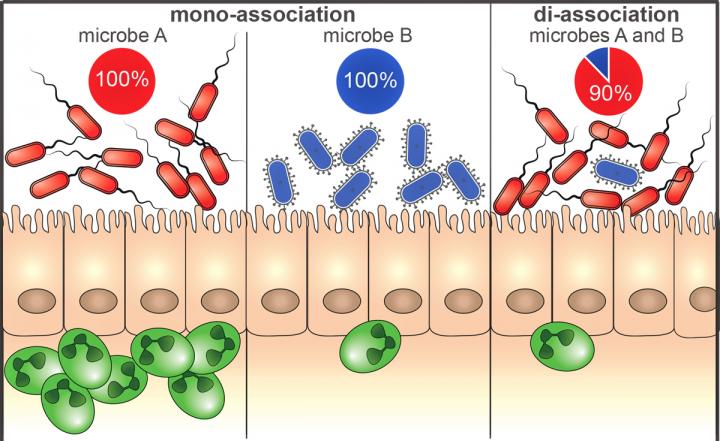Oregon study suggests some gut microbes may be keystones of health

A University of Oregon study finds abundance does not dictate the immune response to bacteria in the guts of zebrafish. This graphic depicts immune response (neutrophils, shown in green) to separate bacterial species, and the response when the two bacteria are placed into a germ-free fish gut at the same time. Courtesy of Annah S. Rolig
University of Oregon scientists have found that strength in numbers doesn't hold true for microbes in the intestines. A minority population of the right type might hold the key to regulating good health.
The discovery, based on research using zebrafish raised completely germ free, is reported in a paper published in the Nov. 11 issue of Cell Host & Microbe. The findings provide a path to study the function of each bacterial species in the gut and to eventually, perhaps, predict and prevent disease, says lead author Annah S. Rolig, a postdoctoral researcher in the UO's Institute of Molecular Biology.
In the project, researchers watched for immune response as isolates of species of bacteria, normally associated with healthy zebrafish, were introduced one at a time and in combination into previously germ-free intestines of the fish.
In a telling sequence, one bacterial species, Vibrio, drew numerous neutrophils, which indicated a rapid inflammatory response in one fish. Another species, Shewanella, inserted into a separate germ-free fish barely attracted an immune response. In a third germ-free fish, both species were introduced together and assembled with a ratio of 90- percent Vibrio to 10-percent Shewanella.
The inflammatory response in the third fish was completely controlled by the low-abundance species.
“Until now, we've only been able to capture proportional information, like you'd see displayed in a pie graph, of the makeup of various microbiota, in percentages of their abundance,” Rolig said. “Biologists in this field have typically assumed an equal contribution based on that makeup.”
Low counts of a bacterial species generally have been discounted in importance, but slight shifts in the ratios of abundant microbe populations have been thought to have roles in obesity, diabetes and inflammatory bowel diseases such as Crohn's disease.
That thinking is now changing, Rolig said. “The contribution of each bacterium is not equal. There is a per-capita effect that needs to be considered.”
The keystone – an important participant that functions to regulate a healthy microbiota – may reside in low-abundant bacterial species. The research team found through additional scrutiny that these species secreted molecules – for now unidentified – that allowed them to dampen the immune response to the whole community.
“Now we've shown that these minor members can have a major impact. If we can identify these keystone species, and find that in a disease state one species may be missing, we might be able to go in with a specific probiotic to restore healthy functioning,” said Rolig, who also is a scientist in the National Institutes of Health-funded Microbial Ecology and Theory of Animals Center for Systems Biology, known as the META Center, at the UO.
To develop a model to capture per-capita contributions of microbes in a population, Rolig and her co-authors — biology graduate student Adam R. Burns, microbiologist Brendan Bohannan of the Institute of Ecology and Evolution and biologist Karen Guillemin, director of the META Center — turned to UO physicist Raghuveer Parthasarathy. His math-driven model, detailed in the paper, provides formulas that predict collective inflammatory responses of combinations of bacteria.
“I'm really proud of this paper because it exemplifies an achievement of one of the major goals of the META Center for Systems Biology, namely to provide a predictive model of how host-microbe systems function,” Guillemin said. “This experimental and modeling framework could be readily generalized to more complex systems such as humans, for example to predict disease severity in individuals with inflammatory bowel disease based on the pro-inflammatory capacity of their gut microbes as assayed in cell culture.”
###
The National Institutes of Health supported the research through grants P50GMO98911 to support the META Center, IF32DK098884 for a postdoctoral fellowship to Rolig and P01HD22486 that supports the UO's zebrafish facility.
Sources: Annah S. Rolig, postdoctoral research associate, UO Institute of Molecular Biology, 541-346-5999, arolig@uoregon.edu, and Karen Guillemin, professor of biology and director of the META Center for Systems Biology, 541-346-5360, guilleman@molbio.uoregon.edu
Note: The UO is equipped with an on-campus television studio with a point-of-origin Vyvx connection, which provides broadcast-quality video to networks worldwide via fiber optic network. There also is video access to satellite uplink and audio access to an ISDN codec for broadcast-quality radio interviews.
Links:
Paper abstract: http://www.
META Center for Systems Biology: http://meta.
Institute of Molecular Biology: http://molbio.
Institute of Ecology and Evolution: http://ie2.
Guillemin faculty page: http://molbio.
Media Contact
All latest news from the category: Life Sciences and Chemistry
Articles and reports from the Life Sciences and chemistry area deal with applied and basic research into modern biology, chemistry and human medicine.
Valuable information can be found on a range of life sciences fields including bacteriology, biochemistry, bionics, bioinformatics, biophysics, biotechnology, genetics, geobotany, human biology, marine biology, microbiology, molecular biology, cellular biology, zoology, bioinorganic chemistry, microchemistry and environmental chemistry.
Newest articles

A ‘language’ for ML models to predict nanopore properties
A large number of 2D materials like graphene can have nanopores – small holes formed by missing atoms through which foreign substances can pass. The properties of these nanopores dictate many…

Clinically validated, wearable ultrasound patch
… for continuous blood pressure monitoring. A team of researchers at the University of California San Diego has developed a new and improved wearable ultrasound patch for continuous and noninvasive…

A new puzzle piece for string theory research
Dr. Ksenia Fedosova from the Cluster of Excellence Mathematics Münster, along with an international research team, has proven a conjecture in string theory that physicists had proposed regarding certain equations….



